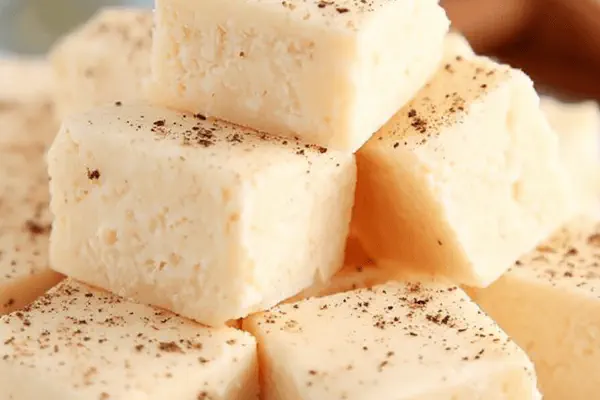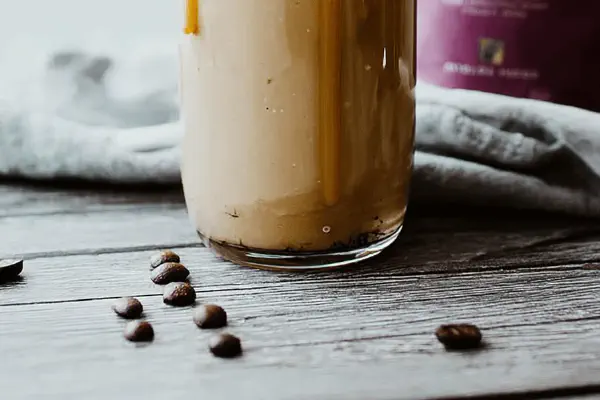Vanilla Cream Fudge

By Emma
Certified Culinary Professional
Ingredients
- 1 cup heavy cream
- 2 cups granulated sugar
- 1/2 cup light corn syrup
- 4 oz white chocolate chips (or chopped white chocolate bars)
- Pinch of fine sea salt
- 5 tbsp unsalted butter (room temp)
- 1 tbsp pure vanilla extract or vanilla bean paste
About the ingredients
Method
- Line a 5x8 glass or metal pan with parchment paper. This pan size yields about a one-inch thick fudge layer; adjust if thicker or thinner fudge is preferred.
- Place heavy cream, sugar, corn syrup, white chocolate, and salt in a heavy-bottomed saucepan. Attach a candy thermometer clipped to the side but not touching bottom. Start heating on low until sugar and white chocolate fully dissolve; mixture will shift from pearly white to creamy beige — about 4–6 minutes. Resist stirring once dissolved; continue heating gradually.
- Ramp heat gently once melted to push temperature toward 238–242°F (soft ball stage). It can take 9 to 11 minutes. Watch the color deepen to light cream, texture thickening visibly. No stirring here—stillness lets candy chemistry develop. Heating longer than 1.5 minutes at target temp risks grainy fudge.
- Remove pan from heat immediately when thermometer reads 240°F or soft ball stage is reached. Pour carefully into a medium bowl. Don’t scrape bottom to avoid burnt sugar bits sneaking in bittering your fudge.
- Whisk in butter and vanilla extract vigorously. Butter melts into softness, vanilla wakes up aroma. Texture thickens and dulls slightly.
- Allow mixture to rest undisturbed for 10–12 minutes at room temperature. It should cool but still be tacky and pliable — this is fudge ready to set, not to spread too thin or stiffen prematurely.
- Transfer the fudge to the prepared pan, smoothing top with an offset spatula or lightly greased back of spoon. Cover loosely with plastic wrap or foil to prevent crusts forming.
- Chill the fudge in fridge at least 7 hours or overnight to fully firm up. Soft and a little springy to the press when ready. If fudge is crumbly, you rushed the cook or overcooked the sugar.
- Lift fudge using parchment edges and cut into 1-inch squares with a sharp knife. For cleaner cuts dip knife in hot water and wipe dry between cuts.
- Store fudge in airtight container in refrigerator. Bring to room temperature briefly before serving to soften. Keeps about 2 weeks refrigerated.
Cooking tips
Chef's notes
- 💡 Heat slow at first till sugar and white chocolate just dissolve—no stirring past pearly creamy stage or risk gritty crystals. Watch shifts in color; creamy beige signals right melt. Timer lies; color and texture speak.
- 💡 Soft ball stage hits 238 to 242°F. Hold 30 to 90 seconds max. Longer at temp dries fudge, grainy sandpaper rough. Silent simmer deepens sound and tone—listen and watch texture thicken but still plump.
- 💡 Butter and vanilla add off heat. Add too early and fats separate, flavor dulls. Whisk fast till butter fully melts in; fudge dulls and thickens just right. Immediate rest after whisk slows flow to spreadable tacky.
- 💡 Chill fudge minimum 7 hours—overnight better. Cut too soon and fudge tears; warm knife in hot water for clean edges, wipe between slices. Parchment edges lift fudge clean from pan, avoid scraping burnt bits.
- 💡 Replace heavy cream with half and half for firmer, less creamy fudge. Cane sugar or honey possible but watch crystal risks; honey slows setting, changes flavor. Corn syrup prevents crystals; golden syrup riskier, more flavor.
Common questions
Why no stirring after sugar melts?
Stirring post melt breaks sugar crystals—run risk of gritty, grainy fudge. Paste smooth texture depends on stillness; sugar chemistry happens best when still. Mix only while melting.
Can I substitute ingredients?
Heavy cream for half and half yields firmer fudge but skimp on creaminess. Cane sugar swaps okay, superfine sugar breaks temperature control. Honey alters setting speed, needs close temp watch.
My fudge came out grainy, what went wrong?
Usually overheated or stirred after sugar melt. Also scraping pan bottom puts in burnt sugar crystals; bitter, grainy mess. Soft ball stage overheating or rushing cooling. Patience needed.
How to store fudge best?
Airtight container in fridge keeps freshness; softens briefly at room temp to eat. Too long outside fridge makes fudge sticky or melts butter. Can freeze but texture shifts; thaw in fridge to firm.



